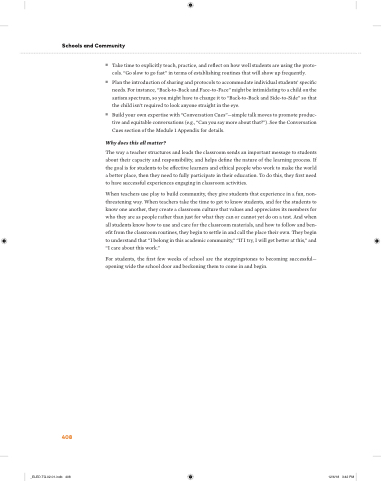Page 434 - EL Grade Teacher Guide - Module 1
P. 434
Schools and Community
Take time to explicitly teach, practice, and re ect on how well students are using the proto- cols. “Go slow to go fast” in terms of establishing routines that will show up frequently.
Plan the introduction of sharing and protocols to accommodate individual students’ speci c needs. For instance, “Back-to-Back and Face-to-Face” might be intimidating to a child on the autism spectrum, so you might have to change it to “Back-to-Back and Side-to-Side” so that the child isn’t required to look anyone straight in the eye.
Build your own expertise with “Conversation Cues”—simple talk moves to promote produc- tive and equitable conversations (e.g., “Can you say more about that?”). See the Conversation Cues section of the Module 1 Appendix for details.
Why does this all matter?
The way a teacher structures and leads the classroom sends an important message to students about their capacity and responsibility, and helps de ne the nature of the learning process. If the goal is for students to be e ective learners and ethical people who work to make the world a better place, then they need to fully participate in their education. To do this, they rst need to have successful experiences engaging in classroom activities.
When teachers use play to build community, they give students that experience in a fun, non- threatening way. When teachers take the time to get to know students, and for the students to know one another, they create a classroom culture that values and appreciates its members for who they are as people rather than just for what they can or cannot yet do on a test. And when all students know how to use and care for the classroom materials, and how to follow and ben- e t from the classroom routines, they begin to settle in and call the place their own. They begin to understand that “I belong in this academic community,” “If I try, I will get better at this,” and “I care about this work.”
For students, the rst few weeks of school are the steppingstones to becoming successful— opening wide the school door and beckoning them to come in and begin.
408
_ELED.TG.02.01.indb 408
12/6/18 3:42 PM


